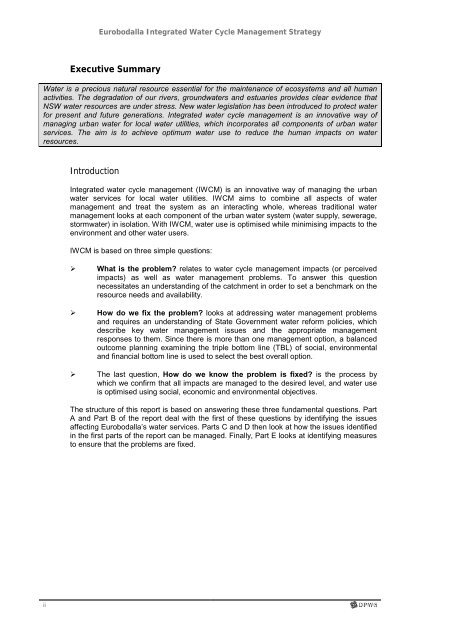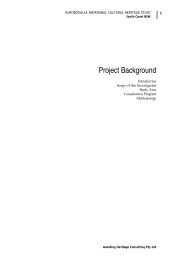- Page 1: Eurobodalla Integrated Water Cycle
- Page 6 and 7: iv Eurobodalla Integrated Water Cyc
- Page 8 and 9: vi Eurobodalla Integrated Water Cyc
- Page 10 and 11: viii Eurobodalla Integrated Water C
- Page 12 and 13: x Eurobodalla Integrated Water Cycl
- Page 14 and 15: xii Eurobodalla Integrated Water Cy
- Page 16 and 17: xiv Eurobodalla Integrated Water Cy
- Page 18 and 19: xvi Eurobodalla Integrated Water Cy
- Page 20 and 21: xviii TABLES Eurobodalla Integrated
- Page 22 and 23: xx Eurobodalla Integrated Water Cyc
- Page 24 and 25: xxii Eurobodalla Integrated Water C
- Page 26 and 27: xxiv Eurobodalla Integrated Water C
- Page 28 and 29: 2 Eurobodalla Integrated Water Cycl
- Page 30 and 31: 4 Eurobodalla Integrated Water Cycl
- Page 32 and 33: 6 Eurobodalla Integrated Water Cycl
- Page 34 and 35: 8 Eurobodalla Integrated Water Cycl
- Page 36 and 37: 10 Eurobodalla Integrated Water Cyc
- Page 38 and 39: 12 Eurobodalla Integrated Water Cyc
- Page 40 and 41: 14 Eurobodalla Integrated Water Cyc
- Page 42 and 43: 16 Eurobodalla Integrated Water Cyc
- Page 44 and 45: FACT SHEET 3 Rainwater Tanks 18 Eur
- Page 46 and 47: 20 Eurobodalla Integrated Water Cyc
- Page 48 and 49: 22 Eurobodalla Integrated Water Cyc
- Page 50 and 51: FACT SHEET 9 Loss Reduction 24 Euro
- Page 52 and 53: 26 Eurobodalla Integrated Water Cyc
- Page 54 and 55:
28 Eurobodalla Integrated Water Cyc
- Page 56 and 57:
30 Eurobodalla Integrated Water Cyc
- Page 58 and 59:
32 Eurobodalla Integrated Water Cyc
- Page 60 and 61:
34 Eurobodalla Integrated Water Cyc
- Page 62 and 63:
36 Eurobodalla Integrated Water Cyc
- Page 64 and 65:
38 Number of Persons 2,500 2,000 1,
- Page 66 and 67:
40 Eurobodalla Integrated Water Cyc
- Page 68 and 69:
42 % Occupancy 80% 70% 60% 50% 40%
- Page 70 and 71:
44 Eurobodalla Integrated Water Cyc
- Page 72 and 73:
46 Annual Volume (ML/Yr) 2,500 2,00
- Page 74 and 75:
48 Demand ML/a Eurobodalla Integrat
- Page 76 and 77:
50 Eurobodalla Integrated Water Cyc
- Page 78 and 79:
52 Eurobodalla Integrated Water Cyc
- Page 80 and 81:
54 Eurobodalla Integrated Water Cyc
- Page 82 and 83:
56 Eurobodalla Integrated Water Cyc
- Page 84 and 85:
6.5.3 Stormwater Issues 58 Euroboda
- Page 86 and 87:
60 Eurobodalla Integrated Water Cyc
- Page 88 and 89:
62 Eurobodalla Integrated Water Cyc
- Page 90 and 91:
64 Eurobodalla Integrated Water Cyc
- Page 92 and 93:
66 Eurobodalla Integrated Water Cyc
- Page 94 and 95:
68 Eurobodalla Integrated Water Cyc
- Page 96 and 97:
70 Eurobodalla Integrated Water Cyc
- Page 98 and 99:
72 Eurobodalla Integrated Water Cyc
- Page 100 and 101:
74 Eurobodalla Integrated Water Cyc
- Page 102 and 103:
76 This page is intentionally blank
- Page 104 and 105:
78 Eurobodalla Integrated Water Cyc
- Page 106 and 107:
80 Eurobodalla Integrated Water Cyc
- Page 108 and 109:
82 Eurobodalla Integrated Water Cyc
- Page 110 and 111:
8.3.2 Immediate Measures 84 Eurobod
- Page 112 and 113:
86 Eurobodalla Integrated Water Cyc
- Page 114 and 115:
88 Eurobodalla Integrated Water Cyc
- Page 116 and 117:
90 Eurobodalla Integrated Water Cyc
- Page 118 and 119:
92 Eurobodalla Integrated Water Cyc
- Page 120 and 121:
94 Eurobodalla Integrated Water Cyc
- Page 122 and 123:
96 Eurobodalla Integrated Water Cyc
- Page 124 and 125:
98 Eurobodalla Integrated Water Cyc
- Page 126 and 127:
100 Eurobodalla Integrated Water Cy
- Page 128 and 129:
102 Eurobodalla Integrated Water Cy
- Page 130 and 131:
104 Eurobodalla Integrated Water Cy
- Page 132 and 133:
9.2 South Durras 9.2.1 Background 1
- Page 134 and 135:
108 Eurobodalla Integrated Water Cy
- Page 136 and 137:
110 Eurobodalla Integrated Water Cy
- Page 138 and 139:
112 Eurobodalla Integrated Water Cy
- Page 140 and 141:
114 Eurobodalla Integrated Water Cy
- Page 142 and 143:
116 Eurobodalla Integrated Water Cy
- Page 144 and 145:
118 Eurobodalla Integrated Water Cy
- Page 146 and 147:
120 Eurobodalla Integrated Water Cy
- Page 148 and 149:
122 Eurobodalla Integrated Water Cy
- Page 150 and 151:
124 Provision of full reticulated s
- Page 152 and 153:
126 Eurobodalla Integrated Water Cy
- Page 154 and 155:
128 Eurobodalla Integrated Water Cy
- Page 156 and 157:
130 Eurobodalla Integrated Water Cy
- Page 158 and 159:
132 Stormwater Eurobodalla Integrat
- Page 160 and 161:
134 Eurobodalla Integrated Water Cy
- Page 162 and 163:
136 Eurobodalla Integrated Water Cy
- Page 164 and 165:
138 Eurobodalla Integrated Water Cy
- Page 166 and 167:
9.5 Mogo 9.5.1 Background 140 Eurob
- Page 168 and 169:
142 Eurobodalla Integrated Water Cy
- Page 170 and 171:
144 Social Issues Eurobodalla Integ
- Page 172 and 173:
146 Eurobodalla Integrated Water Cy
- Page 174 and 175:
148 Eurobodalla Integrated Water Cy
- Page 176 and 177:
150 Eurobodalla Integrated Water Cy
- Page 178 and 179:
152 Eurobodalla Integrated Water Cy
- Page 180 and 181:
154 Eurobodalla Integrated Water Cy
- Page 182 and 183:
156 Eurobodalla Integrated Water Cy
- Page 184 and 185:
158 Eurobodalla Integrated Water Cy
- Page 186 and 187:
160 Eurobodalla Integrated Water Cy
- Page 188 and 189:
162 Eurobodalla Integrated Water Cy
- Page 190 and 191:
164 Eurobodalla Integrated Water Cy
- Page 192 and 193:
166 Eurobodalla Integrated Water Cy
- Page 194 and 195:
168 Eurobodalla Integrated Water Cy
- Page 196 and 197:
170 Eurobodalla Integrated Water Cy
- Page 198 and 199:
172 Eurobodalla Integrated Water Cy
- Page 200 and 201:
174 Eurobodalla Integrated Water Cy
- Page 202 and 203:
176 Eurobodalla Integrated Water Cy
- Page 204 and 205:
9.11 Potato Point 9.11.1 Background
- Page 206 and 207:
180 Eurobodalla Integrated Water Cy
- Page 208 and 209:
182 Eurobodalla Integrated Water Cy
- Page 210 and 211:
184 Eurobodalla Integrated Water Cy
- Page 212 and 213:
186 Eurobodalla Integrated Water Cy
- Page 214 and 215:
188 Eurobodalla Integrated Water Cy
- Page 216 and 217:
190 Eurobodalla Integrated Water Cy
- Page 218 and 219:
192 Eurobodalla Integrated Water Cy
- Page 220 and 221:
194 Eurobodalla Integrated Water Cy
- Page 222 and 223:
196 Eurobodalla Integrated Water Cy
- Page 224 and 225:
198 Eurobodalla Integrated Water Cy
- Page 226 and 227:
200 Eurobodalla Integrated Water Cy
- Page 228 and 229:
9.14.2 What are the Issues? 202 Eur
- Page 230 and 231:
204 Eurobodalla Integrated Water Cy
- Page 232 and 233:
206 Eurobodalla Integrated Water Cy
- Page 234 and 235:
9.15.2 What Are the Issues? 208 Eur
- Page 236 and 237:
210 Eurobodalla Integrated Water Cy
- Page 238 and 239:
212 Eurobodalla Integrated Water Cy
- Page 240 and 241:
214 ML/a 8000 7000 6000 5000 4000 3
- Page 242 and 243:
216 ML/a Eurobodalla Integrated Wat
- Page 244 and 245:
218 Eurobodalla Integrated Water Cy
- Page 246 and 247:
220 Eurobodalla Integrated Water Cy
- Page 248 and 249:
222 Eurobodalla Integrated Water Cy
- Page 250 and 251:
224 Eurobodalla Integrated Water Cy
- Page 252 and 253:
226 Eurobodalla Integrated Water Cy
- Page 254 and 255:
228 SCENARIO 1 Regional Water Suppl
- Page 256 and 257:
230 SCENARIO 3 Regional Water Suppl
- Page 258 and 259:
232 SCENARIO 5 Regional Water Suppl
- Page 260 and 261:
234 SCENARIO 7 Regional Water Suppl
- Page 262 and 263:
236 Eurobodalla Integrated Water Cy
- Page 264 and 265:
238 Eurobodalla Integrated Water Cy
- Page 266 and 267:
240 Eurobodalla Integrated Water Cy
- Page 268 and 269:
242 Eurobodalla Integrated Water Cy
- Page 270:
244 Eurobodalla Integrated Water Cy

















